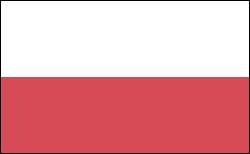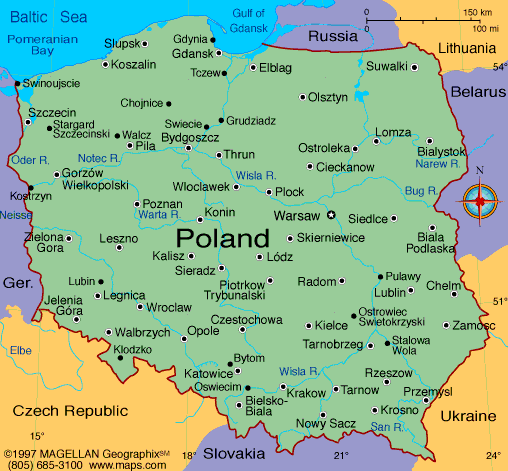POLAND

Geography: Poland, a country the size of New Mexico, is in north-central Europe. Most of the country is a plain with no natural boundaries except the Carpathian Mountains in the south and the Oder and Neisse rivers in the west. Other major rivers, which are important to commerce, are the Vistula, Warta, and Bug.
Government: Democratic republic.
History: Great (north) Poland was founded in 966 by Mieszko I, who belonged to the Piast dynasty. The tribes of southern Poland then formed Little Poland. In 1047, both Great Poland and Little Poland united under the rule of Casimir I the Restorer. Poland merged with Lithuania by royal marriage in 1386. The Polish-Lithuanian state reached the peak of its power between the 14th and 16th centuries, scoring military successes against the (Germanic) Knights of the Teutonic Order, the Russians, and the Ottoman Turks.
Lack of a strong monarchy enabled Russia, Prussia, and Austria to carry out a first partition of the country in 1772, a second in 1792, and a third in 1795. For more than a century thereafter, there was no Polish state, just Austrian, Prussian, and Russian sectors, but the Poles never ceased their efforts to regain their independence. The Polish people revolted against foreign dominance throughout the 19th century. Poland was formally reconstituted in Nov. 1918, with Marshal Josef Pilsudski as chief of state. In 1919, Ignace Paderewski, the famous pianist and patriot, became the first prime minister. In 1926, Pilsudski seized complete power in a coup and ruled dictatorially until his death on May 12, 1935.
Despite a ten-year nonaggression pact signed in 1934, Hitler attacked Poland on Sept. 1, 1939. Soviet troops invaded from the east on Sept. 17, and on Sept. 28, a German-Soviet agreement divided Poland between the USSR and Germany. Wladyslaw Raczkiewicz formed a government-in-exile in France, which moved to London after France's defeat in 1940. All of Poland was occupied by Germany after the Nazi attack on the USSR in June 1941. Nazi Germany's occupation policy in Poland was designed to eradicate Polish culture through mass executions and to exterminate the country's large Jewish minority.
The Polish government-in-exile was replaced with the Communist-dominated Polish Committee of National Liberation by the Soviet Union in 1944. Moving to Lublin after that city's liberation, it proclaimed itself the Provisional Government of Poland. Some former members of the Polish government in London joined with the Lublin government to form the Polish Government of National Unity, which Britain and the U.S. recognized. On Aug. 2, 1945, in Berlin, President Harry S. Truman, Joseph Stalin, and Prime Minister Clement Attlee of Britain established a new de facto western frontier for Poland along the Oder and Neisse rivers. (The border was finally agreed to by West Germany in a nonaggression pact signed on Dec. 7, 1970.) On Aug. 16, 1945, the USSR and Poland signed a treaty delimiting the Soviet-Polish border. Under these agreements, Poland was shifted westward. In the east, it lost 69,860 sq mi (180,934 sq km); in the west, it gained (subject to final peace conference approval) 38,986 sq mi (100,973 sq km).
Government: Democratic republic.
History: Great (north) Poland was founded in 966 by Mieszko I, who belonged to the Piast dynasty. The tribes of southern Poland then formed Little Poland. In 1047, both Great Poland and Little Poland united under the rule of Casimir I the Restorer. Poland merged with Lithuania by royal marriage in 1386. The Polish-Lithuanian state reached the peak of its power between the 14th and 16th centuries, scoring military successes against the (Germanic) Knights of the Teutonic Order, the Russians, and the Ottoman Turks.
Lack of a strong monarchy enabled Russia, Prussia, and Austria to carry out a first partition of the country in 1772, a second in 1792, and a third in 1795. For more than a century thereafter, there was no Polish state, just Austrian, Prussian, and Russian sectors, but the Poles never ceased their efforts to regain their independence. The Polish people revolted against foreign dominance throughout the 19th century. Poland was formally reconstituted in Nov. 1918, with Marshal Josef Pilsudski as chief of state. In 1919, Ignace Paderewski, the famous pianist and patriot, became the first prime minister. In 1926, Pilsudski seized complete power in a coup and ruled dictatorially until his death on May 12, 1935.
Despite a ten-year nonaggression pact signed in 1934, Hitler attacked Poland on Sept. 1, 1939. Soviet troops invaded from the east on Sept. 17, and on Sept. 28, a German-Soviet agreement divided Poland between the USSR and Germany. Wladyslaw Raczkiewicz formed a government-in-exile in France, which moved to London after France's defeat in 1940. All of Poland was occupied by Germany after the Nazi attack on the USSR in June 1941. Nazi Germany's occupation policy in Poland was designed to eradicate Polish culture through mass executions and to exterminate the country's large Jewish minority.
The Polish government-in-exile was replaced with the Communist-dominated Polish Committee of National Liberation by the Soviet Union in 1944. Moving to Lublin after that city's liberation, it proclaimed itself the Provisional Government of Poland. Some former members of the Polish government in London joined with the Lublin government to form the Polish Government of National Unity, which Britain and the U.S. recognized. On Aug. 2, 1945, in Berlin, President Harry S. Truman, Joseph Stalin, and Prime Minister Clement Attlee of Britain established a new de facto western frontier for Poland along the Oder and Neisse rivers. (The border was finally agreed to by West Germany in a nonaggression pact signed on Dec. 7, 1970.) On Aug. 16, 1945, the USSR and Poland signed a treaty delimiting the Soviet-Polish border. Under these agreements, Poland was shifted westward. In the east, it lost 69,860 sq mi (180,934 sq km); in the west, it gained (subject to final peace conference approval) 38,986 sq mi (100,973 sq km).

Map of Poland
President: Andrzej Duda (2015)
Prime Minister: Ewa Kopacz
(2014)
Land area: 117,571 sq mi (304,509 sq km);
total area: 120,728 sq mi (312,685 sq km)
Population (2014 est.): 38,346,279 (growth
rate: -0.11%); birth rate: 9.77/1000; infant mortality rate: 6.19/1000;
life expectancy: 76.65
Capital and largest city (2011 est.):
Warsaw, 1.723 million
Other large city: Krakow 756,000 (2011)
Monetary
unit: Zloty
National
name: Rzeczpospolita Polska
Language:
Polish (official) 96.2%, Polish and non-Polish 2%, non-Polish 0.5%, unspecified 1.3% (2011 est.)
Ethnicity/race:
Polish 96.9%, German 0.2%, Silesian 1.1%,
Ukrainian 0.1%, other and unspecified 1.7% (2011)
Religions:
Catholic 87.2% (includes Roman Catholic 86.9% and
Greek Catholic, Armenian Catholic, and Byzantine-Slavic Catholic .3%),
Orthodox 1.3% (almost all are Polish Autocephalous Orthodox), Protestant
0.4% (mainly Augsburg Evangelical and Pentacostal), other 0.4%
(includes Jehovah's Witness, Buddhist, Hare Krishna, Gaudiya
Vaishnavism, Muslim, Jewish, Mormon), unspecified 10.8% (2012)
Literacy rate: 99.7% (2011 est.)
Economic summary: GDP/PPP $814 billion (2013 est.); per capita $21,100. Real growth rate: 1.3%.
Inflation: 1%. Unemployment:10.3%. Arable
land: 35.49% (2011). Agriculture: potatoes, fruits, vegetables,
wheat; poultry, eggs, pork, dairy. Labor force: 18.22 million (2013);
agriculture 12.9%, industry 30.2%, services 57% (2010).
Industries: machine building, iron and steel, coal mining,
chemicals, shipbuilding, food processing, glass, beverages, textiles.
Natural resources: coal, sulfur, copper, natural gas, silver,
lead, salt, amber, arable land. Exports: $202.3 billion (2013 est.): machinery and transport equipment 37.8%, intermediate
manufactured goods 23.7%, miscellaneous manufactured goods 17.1%, food
and live animals 7.6% (2013). Imports: $207.4 billion (2013 est.): machinery and transport equipment 38%, intermediate
manufactured goods 21%, chemicals 15%, minerals, fuels, lubricants,
and related materials 9% (2011). Major trading partners:
Germany, France, UK, Italy, Czech Republic, Netherlands, Russia, China (2012).
Communications:
Telephones: 6.125 million (2012); mobile
cellular: 50.84 million (2012). Broadcast media: state-run
public television operates 2 national channels supplemented by 16
regional channels and several niche channels; privately-owned entities
operate several national TV broadcast networks and a number of special
interest channels; large number of privately-owned channels
broadcasting locally; roughly half of all households are linked to
either satellite or cable TV systems providing access to foreign
television networks; state-run public radio operates 5 national networks
and 17 regional radio stations; 2 privately-owned national radio
networks, several commercial stations broadcasting to multiple cities,
and a large number of privately-owned local radio stations (2007). Internet Service Providers (ISPs):13.265 million (2012). Internet users:22.452 million (2009).
Transportation: Railways: total: 19,428 km
(2007). Highways: total: 412,035 km; paved: 280,719 km (includes 2,418 km of expressways); unpaved: 131,316 km (2012).
Waterways: 3,997 km navigable rivers and canals (2009).
Ports and terminals: Gdansk, Gdynia, Swinoujscie, Szczecin. Airports:126 (2013).
International disputes:
As a member state that forms part of the EU's external border, Poland
has implemented the strict Schengen border rules to restrict illegal
immigration and trade along its eastern borders with Belarus and
Ukraine.
-------------------- o --------------------
No comments:
Post a Comment